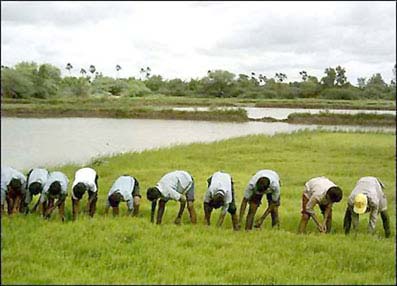An organic agriculture can help the world fight poverty
Organic agriculture (NNHC), as defined by the United Nations, is a natural farming and farming system that does not use chemicals as fertilizers and pesticides, helps to reduce pollution and ensure health. for people and pets.
Organic food has long been considered a small market, and luxury is only for the middle and upper classes. However, scientists believe that moving a large part of agriculture into organic modalities can help curb world poverty and contribute to improving the environment.
At the UN Conference on ' Organic Agriculture and Food Security ' which took place in Rome (Italy), experts from the Danish Center for Agricultural and Organic Food Research identified food security for the surrounding area. Sahara Desert (Africa) will be guaranteed if from now until 2020, 50% of agricultural land in the region specializing in exportation here is converted to production by organic technology.
Research results of the center show that when returning to traditional natural farming methods, farmers will not have to spend money to buy medicine and chemical fertilizers, and can diversify crops and cultivate in a sustainable way. strong. Moreover, if agricultural products are certified as organic, growers can export at a higher price than normal agricultural products.
According to the United Nations Food and Agriculture Organization (FAO), the NNHC is capable of ensuring a sufficient supply of food to feed the population in the world today in parallel with minimizing adverse impacts on the environment. A study by the University of Michigan (USA) showed that if the world switched to NNHC, it would create from 2,641 to 4,381 kilocalorie per person per day compared with the current world food production of 2.786 kilocalorie for one person / day.

(Photo: SMH)
The farming method by organic technology is currently being applied in 120 countries . This trend is increasing rapidly in India, China and Latin American countries. Worldwide, more than 26 million hectares of agricultural land are being managed under organic technology - a relatively small proportion (about 1-2%) in global agriculture. New China has more than 1,000 agricultural and farm companies certified to produce using organic technology.
In India, about 2.5 million hectares of farms are granted organic production certification. In 2006, the global organic farming market for agricultural products was estimated at US $ 40 billion, up about 10 billion from the previous year. Particularly in China, the value of organic agricultural exports increased from less than 1 million USD in the mid-1990s to over 200 million USD today.
Europe and North America are currently the two largest markets for organic agricultural products, and the demand is constantly increasing, creating opportunities for developing countries to export clean agricultural products to these markets. However, the current difficulty is how to identify the agricultural products produced by clean organic technology and market them, even in the domestic market in developing countries.
Currently, the International Fund for Agriculture and Development (IFAD), the UN's specialized agency on poverty reduction issues, is helping countries to rapidly increase their farming areas with organic technology, and to assist countries in Develop harmoniously integrating private manufacturing sector to provide organic agricultural product reception services. According to IFAD, strengthening the application of organic farming technology will also help create new jobs in rural areas, helping to limit the wave of rural-urban migration.
In Vietnam, the Central Farmers' Association plans this year to establish farmer clubs to produce NNHC in order to promote the exchange and study of economics and link production and supply of vegetable products. , fruits, food - safe food to consumers. Last year, the Farmer's Union experimented with NNHC cultivation methods on vegetables, rice, oranges, litchi and freshwater fish in the provinces of Lao Cai, Tuyen Quang, Bac Giang, Bac Ninh, Vinh Phuc and Hai Phong.
DUC NHAN & VIETNAM
- Keeping food security during the economic crisis
- Poverty affects the thinking ability of the brain
- The reason many people prefer organic food
- DNA of people affected by poverty
- 12 ways Israelis change world agriculture (P1)
- Organic solar cells set a new world record for performance
- Russian lasers will save the world from hunger
- New discovery of the history of agriculture in Eurasia
- Organic food is not as good as advertising
- Africa reduced poverty due to ... camel milk
- This small robot will revolutionize agriculture
- Poverty can affect brain development
 Why do potatoes have eyes?
Why do potatoes have eyes? 'Tragedy' the world's largest carnivorous life: Death becomes ... public toilet
'Tragedy' the world's largest carnivorous life: Death becomes ... public toilet Tomatoes were once considered 'poisonous' for 200 years
Tomatoes were once considered 'poisonous' for 200 years Detecting microscopic parasites on human face
Detecting microscopic parasites on human face Forget AI, the Age of Organic Intelligence Has Arrived: Bold Technology Makes Computer Chips Obsolete
Forget AI, the Age of Organic Intelligence Has Arrived: Bold Technology Makes Computer Chips Obsolete  New research reveals the hidden downsides of organic farming
New research reveals the hidden downsides of organic farming  'Building blocks of life' found on Mars
'Building blocks of life' found on Mars  NASA finds new form of 'building blocks of life' on Mars?
NASA finds new form of 'building blocks of life' on Mars?  Discovered organic molecules that can make life in the central Milky Way
Discovered organic molecules that can make life in the central Milky Way  Vietnam will have a gate to the origin of agricultural products
Vietnam will have a gate to the origin of agricultural products 